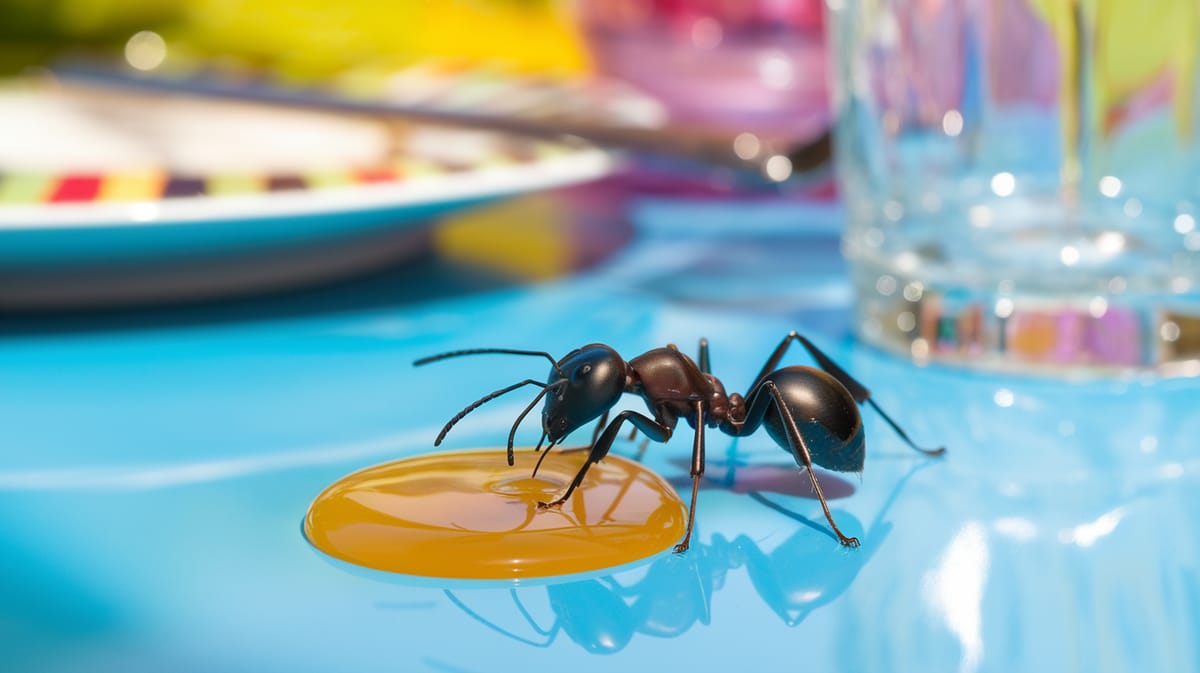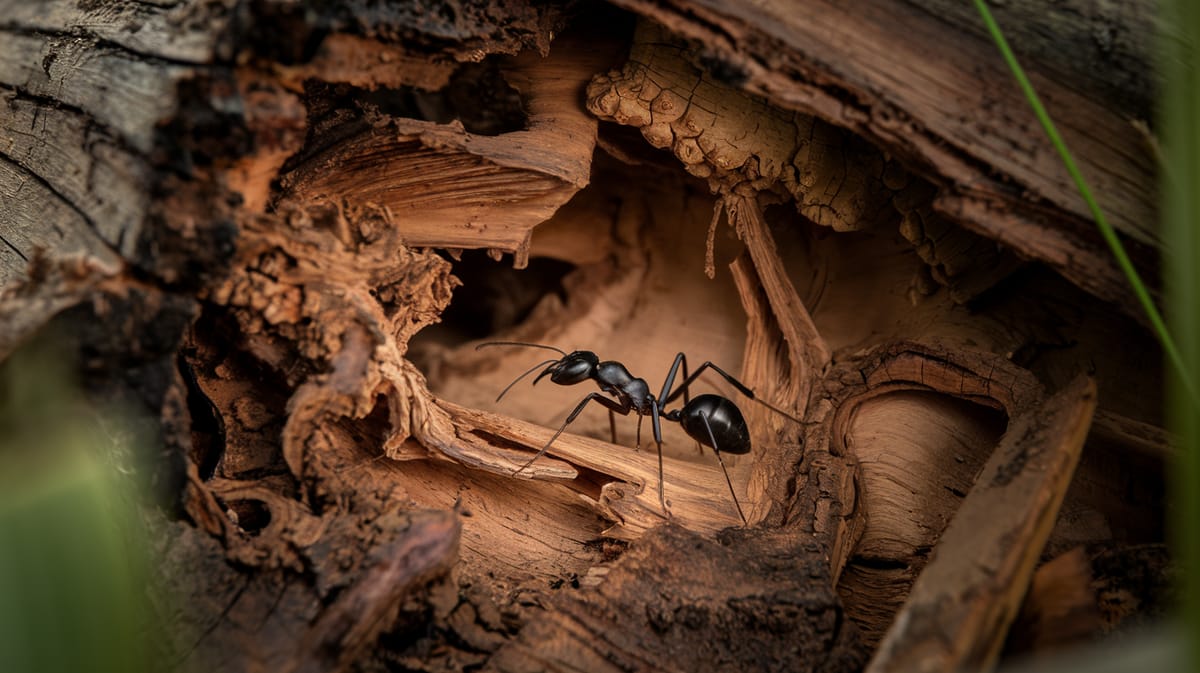Carpenter Ant
Renowned for their teamwork and resourcefulness, carpenter ants play a crucial role in breaking down decayed wood, aiding forest health. Their tunnel networks facilitate nutrient cycling.

Key Insights at a Glance
Did You Know?
Taxonomy & Classification
Carpenter ants, known for their wood-boring abilities, play a crucial ecological role in decomposing dead trees and facilitating nutrient cycling. Let's understand the evolutionary journey and classification of these remarkable decomposers.
Species Diversity
Carpenter ants belong to the genus Camponotus, comprising over 1,000 species globally, each adapted to diverse environments.
Evolutionary Adaptations
Originating around 50 million years ago, carpenter ants evolved unique glandular secretions to protect their colonies from pathogens and predators.
Lifecycle and Growth
A remarkable journey of transformation from Egg to Adult.
Egg
Carpenter ant eggs, laid by the queen, are tiny, oval, and white, developing in a protected chamber within the nest.
Larva
Larvae are fed by worker ants and grow rapidly, shedding their skin multiple times before pupating.
Pupa
Pupae resemble adults but are immobile and encased in a cocoon, undergoing transformation into their final form.
Adult
Adults emerge to take on roles like foraging, defending, or expanding the colony, showcasing social organization.
Dietary Habits
Adaptable foragers with diverse feeding strategies, they rely on plant sap, honeydew, and insect prey for sustenance.
| DIET TYPE | DESCRIPTION |
|---|---|
| Primary Diet | Primarily feeds on honeydew from aphids and other insects, providing essential sugars and nutrients. |
| Secondary Diet | Consumes plant materials like fruits and sap for additional carbohydrates and energy. |
| Occasional | Occasionally scavenges on dead insects or human food scraps when natural sources are scarce. |

Behaviour and Adaptations
Discover the fascinating traits that enable Carpenter Ants to thrive in their environments.
Structural Foraging
Carpenter ants create complex tunnel systems to efficiently locate food sources.
Chemical Communication
They use pheromones for precise navigation and colony coordination.
Defensive Mandibles
Powerful mandibles offer defense and aid in construction and food gathering.
Ecosystem Impact
Essential role of Carpenter Ants in ecological balance and sustainability.
Decomposition Facilitators
Breaks down dead wood, returning nutrients to the soil.
Soil Aerators
Enhances soil structure through tunneling activities, improving plant root growth.
Biodiversity Promoters
Supports various species by creating habitats through their nest construction.
Conservation Challenges
Understanding and addressing the major threats to Carpenter Ant populations.
Habitat Loss
Deforestation reduces their nesting sites and resources.
Chemical Exposure
Pesticides and chemicals disrupt their natural habitats and populations.
Climate Change
Altered weather patterns affect their survival and breeding cycles.
Frequently Asked Questions
How long do Carpenter Ants live?
Carpenter ants can live up to seven years, with queens typically living longer than workers. Workers generally survive from a few months to a couple of years, while queens can live for several years, ensuring the colony's continuity.
What do Carpenter Ants eat?
Carpenter ants primarily feed on honeydew produced by aphids, insects, and plant juices. They also consume protein-rich foods like dead insects. They do not eat wood but excavate it to create nests.
Are Carpenter Ants poisonous?
Carpenter ants are not poisonous. They pose no health risks from toxins. However, they can cause structural damage to wooden structures by hollowing out wood to build their nests.
Are Carpenter Ants endangered?
Carpenter ants are not considered endangered. They are common in many parts of the world and thrive in various environments, from forests to urban areas. Their populations are stable, and they are not at risk of extinction.
What do Carpenter Ants symbolize?
Carpenter ants often symbolize resilience, teamwork, and industriousness. Their ability to work collectively in colonies and their persistence in building and maintaining nests reflect these qualities.
Do Carpenter Ants bite?
Carpenter ants can bite if threatened. Their bites can be painful due to their strong mandibles, and they may spray formic acid into the wound, causing a burning sensation. Bites are not dangerous to humans.
What color are Carpenter Ants?
Carpenter ants are typically black or dark brown. Some species may have reddish or yellowish hues. Their color can vary slightly depending on the species and region.
Does a Carpenter Ant have wings?
Carpenter ants can have wings, but only the reproductive members, known as alates, possess them. These winged ants, both male and female, emerge during mating season to establish new colonies.
What does a Carpenter Ant look like?
Carpenter ants have a segmented body with three main parts: head, thorax, and abdomen. They feature elbowed antennae, strong mandibles, and a distinctive, smooth thorax. They range in size from 6 to 12 millimeters.
Is a Carpenter Ant an insect?
Yes, a carpenter ant is an insect. It belongs to the family Formicidae and the order Hymenoptera. Like all insects, carpenter ants have a three-part body structure, six legs, and a pair of antennae.
Related Insects
Discover insects with similar characteristics to Carpenter Ant - including shared habitats, diets, and taxonomic classifications
Share this profile
Help others discover Carpenter Ant
